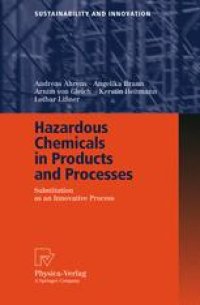
Ebook: Hazardous Chemicals in Products and Processes: Substitution as an Innovative Process
Author: Andreas Ahrens Angelika Braun Professor Arnim von Gleich Kerstin Heitmann Lothar Lißner (auth.)
- Tags: R & D/Technology Policy, Safety in Chemistry Dangerous Goods, Technology Management, Ecotoxicology
- Series: Sustainability and Innovation
- Year: 2006
- Publisher: Physica-Verlag Heidelberg
- Edition: 1
- Language: English
- pdf
Substitution of hazardous substances is a prioritised objective in chemical regulation and risk management. However, it is experienced as a tough task with often inconsistent results. Based on thirteen case studies, this book analyzes substitution as an innovation process and attempts to give answers to the following questions: Why and under which circumstances are companies able and willing to substitute hazardous substances? What are the main drivers and the main barriers? In which way can communication along the supply chain support environmental innovation? How can risk management appropriately deal with the lack of knowledge, with uncertainties and incomplete knowledge about the possible effects of different substances? Recommendations for action are provided for commercial and state institutions and consumers and thus for all actors engaged in the European reform of chemicals policy following the REACH system.
Substitution of hazardous substances is a prioritised objective in chemical regulation and risk management. However, it is experienced as a tough task with often inconsistent results. Based on thirteen case studies, this book analyzes substitution as an innovation process and attempts to give answers to the following questions: Why and under which circumstances are companies able and willing to substitute hazardous substances? What are the main drivers and the main barriers? In which way can communication along the supply chain support environmental innovation? How can risk management appropriately deal with the lack of knowledge, with uncertainties and incomplete knowledge about the possible effects of different substances? Recommendations for action are provided for commercial and state institutions and consumers and thus for all actors engaged in the European reform of chemicals policy following the REACH system.
Substitution of hazardous substances is a prioritised objective in chemical regulation and risk management. However, it is experienced as a tough task with often inconsistent results. Based on thirteen case studies, this book analyzes substitution as an innovation process and attempts to give answers to the following questions: Why and under which circumstances are companies able and willing to substitute hazardous substances? What are the main drivers and the main barriers? In which way can communication along the supply chain support environmental innovation? How can risk management appropriately deal with the lack of knowledge, with uncertainties and incomplete knowledge about the possible effects of different substances? Recommendations for action are provided for commercial and state institutions and consumers and thus for all actors engaged in the European reform of chemicals policy following the REACH system.
Content:
Front Matter....Pages I-VII
Introduction....Pages 1-3
Summary of most important results....Pages 5-19
Initial situation and analysis of deficits....Pages 21-45
Approach to research and procedure....Pages 47-59
Case study analysis and development of hypotheses....Pages 61-107
Developing model — being innovative in an innovation system....Pages 109-118
Dealing with lack of knowledge and uncertainties — a task for risk management....Pages 119-135
Recommendations for action....Pages 137-141
Prospects and prospective questions....Pages 143-143
Back Matter....Pages 145-152
Substitution of hazardous substances is a prioritised objective in chemical regulation and risk management. However, it is experienced as a tough task with often inconsistent results. Based on thirteen case studies, this book analyzes substitution as an innovation process and attempts to give answers to the following questions: Why and under which circumstances are companies able and willing to substitute hazardous substances? What are the main drivers and the main barriers? In which way can communication along the supply chain support environmental innovation? How can risk management appropriately deal with the lack of knowledge, with uncertainties and incomplete knowledge about the possible effects of different substances? Recommendations for action are provided for commercial and state institutions and consumers and thus for all actors engaged in the European reform of chemicals policy following the REACH system.
Content:
Front Matter....Pages I-VII
Introduction....Pages 1-3
Summary of most important results....Pages 5-19
Initial situation and analysis of deficits....Pages 21-45
Approach to research and procedure....Pages 47-59
Case study analysis and development of hypotheses....Pages 61-107
Developing model — being innovative in an innovation system....Pages 109-118
Dealing with lack of knowledge and uncertainties — a task for risk management....Pages 119-135
Recommendations for action....Pages 137-141
Prospects and prospective questions....Pages 143-143
Back Matter....Pages 145-152
....